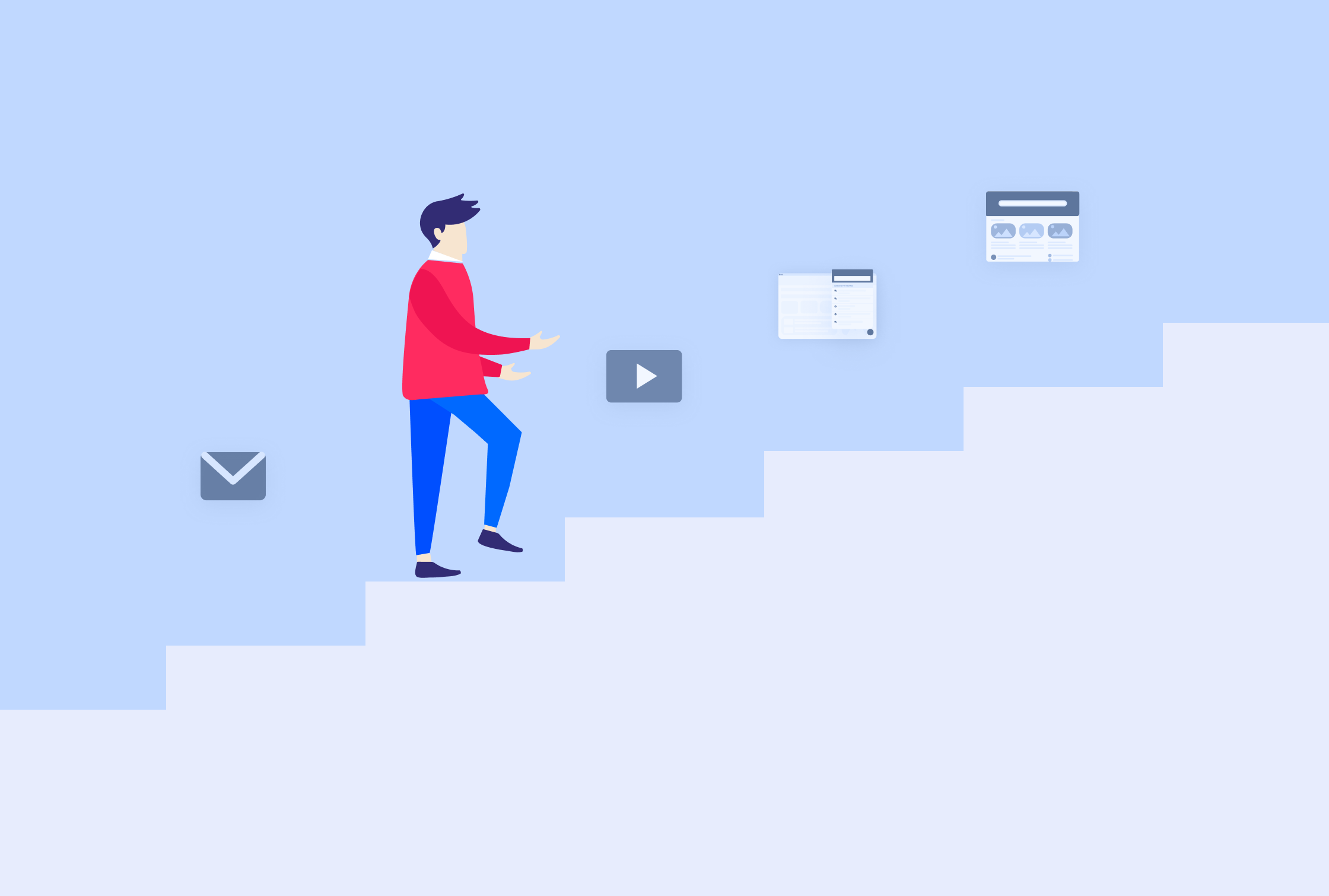Now that Integration Week is a wrap, it’s time to put our focus back on This is Digital Customer Success – the blog series where we set out to get clarity on all things Digital CS. In our previous post, we took a closer look at some of the key channels for your digital-led customer journey. This week, as promised, it’s time to get practical!
Building out your first Digital Customer Success program can be daunting. Where do you start? Like we mentioned in the previous post, the key to getting started is to start simple.
Your guiding light when building out your channel strategy is your customer journey and the key product behaviors you’ve identified. On top of that, you want to look at how you can take the load off your CSMs. But you want to do this one step at a time.
Let’s take a look.
Start simple: The step-by-step approach to building out your digital channels
The goal of your channel strategy is not just to drive the key product behaviors you’ve identified, but also to put the power into the hands of your customers. It’s about enabling them to get to value faster.
With that said, here are two things you need to think about:
- What are the key behaviors you want customers to achieve?
- How can we lighten the load for our CSMs?
With your roadmap in hand, customer success plans, and your overall goals towards positive Net Retention, you know the answer to the first question already – great! Answering the second question shouldn’t be too difficult.
So let’s take a step back and ask this:
- How are your CSMs currently engaging with customers and what could that look like at scale?
- What channels are your customers choosing to engage with your CSMs and/or your company?
- What tasks or steps in the customer journey can you automate and bring into the digital journey?
Start by looking at the repetitive tasks your CSMs are doing for users, e.g. are they sending the same standardized message to all users during onboarding? Then look at where and how that message fits into driving key behaviors and automate it. Certain messaging or steps of the onboarding flow will be similar for some customers. For example, when you’re informing them about how to use certain core features, or how to set up their profile. Valuable, but primed for automation.
Gainsight’s Lane Holt has it down: “Let’s say that, on average, it takes 10 minutes to send an email to a customer and your team has 40 customers, that can be a lot of time just asking them to make sure one message gets to the right person. So if we can take that off of them and build that into our digital success strategy, we’re more likely to help those CSMs and our customers be successful.”
Now, let’s look at how you can start building out those steps.
Build a “one-step journey”
When we said “start simple,” we meant it. The first step in building out your digital CS program starts with a one-step journey. Let’s go back to the example we used earlier in the series.
You’re the VP of Customer Success at a SaaS company. You’ve identified a set of key behaviors that need to happen in the first two weeks of onboarding:
- Use feature X
- Use feature Y
- Achieve outcome Z
Instead of mapping out all the touchpoints to drive these behaviors, you start with one. Here, we start with a simple email prompting the user to log in.
For each step, you want to have a clear message that prompts one action for the user along with the metrics that measure success.
In this case, your metrics for success will be open rate, click-through rate, and product logins. Before you set up the email, also make sure that you create benchmarks for your metrics. E.g If you send the email prompt to 100 customers, ask:
- What does a good open rate look like?
- What does a good click-through rate look like?
- What does a good login rate look like?
Once you’ve defined your benchmarks, it’s time to start testing. Below is what that first step could look like. Once that first step is completed it’s time to look at the data. Did you hit the benchmarks for success?
Once that first step is completed it’s time to look at the data. Did you hit the benchmarks for success?
If you didn’t, it’s time to iterate. Perhaps the subject line wasn’t compelling enough. Perhaps the messaging didn’t work and it was unclear what the user was supposed to do? Keep iterating until you hit the benchmarks. Only when you do, you can add on the next step. (FYI, yes, this is exactly how Marketers optimize their campaigns!)
Now the steps might look something like this:  Once you have that initial process built, whether that’s a welcome email, an in-app engagement, or a combination of them, you can copy that, iterate on it, and make sure that it’s used as a template moving forward and you see that it’s driving the desired behaviors across the board.
Once you have that initial process built, whether that’s a welcome email, an in-app engagement, or a combination of them, you can copy that, iterate on it, and make sure that it’s used as a template moving forward and you see that it’s driving the desired behaviors across the board.
And that’s how you start really simple. You create an initial one-step journey, followed by additional steps that when combined drive the key behaviors you have identified in your customer roadmap. Ultimately, you’ll end up with a self-serve guided experience that helps customers create value.
Now, we know this sounds like barging down an already open door. (And it’s true.) But we also find that a lot of Customer Success teams struggle to untangle the web of channels, use-cases, tooling, and processes. So much has been written about it, yet so little actually offers you a quick-fire way of getting started and making the process your own. The process above, while simple – does.
Don’t overdo it
Message overload is a real thing. Lane Holt points out that “We can sometimes create message overload. […] Be aware of who’s receiving what message, how frequently the messages are being received, and how frequently the person at the other end is getting a message. This can include emails, in-app messages, engagements with your users, events, meetings, webinars, all of those things come together. And we need to be careful of that tipping point, and that’s unique to the different personas in your users of what that tipping point can be.”
A good practice is to keep track of all engagements in a timeline of sorts, e.g. through your Customer Success CRM. Especially when you’re automating more messages, it can be daunting to keep track of who you send what from just memory only. To reference similarities with Marketing campaigns again, this is why they use a content calendar.
Final words
You might think you’re starting at the very beginning, but you’re not. Digital success is already happening across your company. It’s happening in pockets of your business (such as marketing and product), but there just might not yet be a way to understand and see what’s happening from a holistic perspective.
So as you build out your channels, remember this: Start simple, use it as a template, iterate and improve.
Come back next week for another installment when we’ll talk about the Digital CS tech stack. Subscribe to our blog to make sure you don’t miss it!


